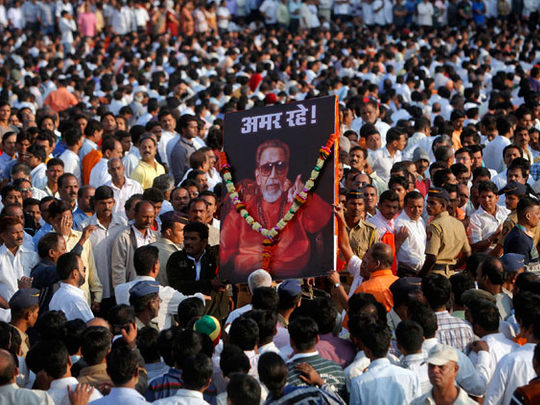
The death of firebrand Hindu nationalist leader Balasaheb Thackeray at the age of 86 has left a void in the right-wing political spectrum that occupies a dominant space in Indian democracy. He was on life support since November 15 and died on Saturday at Matoshree, his Mumbai home from where he remote-controlled India’s financial and film capital for the last several decades.
Thackeray belonged to a rare breed of politicians who never minced words in airing his beliefs and never hesitated in taking extreme right-wing political positions. His following went beyond hundreds of thousands of his party, Shiv Sena, workers who worshipped him and followed his every word. His editorials in Marathi-language Samna, a newspaper he founded in 1989, made headlines and set the agenda for Hindu nationalists in the country.
On the night of November 15, when the ailing Thackeray was put on life support, more than 25,000 Shiv Sena activists gathered outside his home in Mumbai’s posh suburb of Bandra. Soon after, a battery of VVIPs, including Bollywood stars, directors and politicians began arriving at his home. First to show up was Bollywood superstar Amitabh Bachchan and his son Abhishek. Salman Khan and Shah Rukh Khan followed soon after. Alarmed by the swelling crowd of Thackeray supporters, who have a history of violence and vandalism, administrators in Mumbai cancelled all leaves of policemen and officials. The following morning, Mumbai woke up to deserted roads and closed markets, unusual on a working day. “One man’s fate holds Mumbai to ransom,” read the facebook status of a journalist. Fearing large-scale disturbance, President Pranab Mukherjee’s trip to the metropolis was cancelled. So were shootings in India’s film capital. Mumbai came to a halt that day.
Thackeray was no ordinary politician. Such was the terror of the “Tiger of Maharashtra”, a title given by his supporters, that TV channels and newspapers shied away from speculating on his condition and media outlets relied strictly on official medical bulletins or briefings by family members. In the past, Shiv Sena members have violently attacked media organisations for reporting against Thackeray or his party. No media outlet was willing to take chance this time.
In his political life, Thackeray, a rabble rouser, made most public appearances sporting dark glasses and saffron robes, sitting on a golden throne flanked by tiger heads on the arm rests. Before joining politics, Thackeray was a cartoonist working with Free Press Journal, a newspaper he joined in 1950s. He founded Shiv Sena in 1966 and launched a tirade against south Indians living in Mumbai. His campaign led to violence against people from Tamil Nadu, Karnataka and Kerala who lived and worked in Mumbai. He accused the south Indians of taking up jobs meant for Marathi-speaking people, his core constituency.
Thackeray built his career by practising politics of hate. After targeting south Indians, Thackeray trained his guns on the Hindi-speaking migrants from Uttar Pradesh and Bihar. However, his favourite punching bag was the Muslim community who he projected as a threat to Hindus’ survival, an enemy of India and likened Muslims to cancer. A commission of inquiry indicted him for leading a well-orchestrated campaign of violence in 1993 when a large number of Muslims were killed in Mumbai. The commission report stated: “There is no doubt that the Shiv Sena and Shiv Sainiks took the lead in organising attacks on Muslims and their properties under the guidance of several leaders of the Shiv Sena from the level of Shakha Pramukh to the Shiv Sena Pramukh, Bal Thackeray, who, like a veteran general, commanded his loyal Shiv Sainiks to retaliate by organised attacks against Muslims.”
Despite this indictment, no government dared to drag him to a court of law. The only punishment he got was from the Election Commission that banned him from voting and contesting elections for six years.
His rabble rousing and politics of hate never affected his fan following among the poor, middle class, businessmen, famous Bollywood personalities and politicians of all class. Politicians and film stars — some passionately, others grudgingly — feted him and never missed a chance to pay obeisance to him. From top industrialists to small-time film directors, all were at his beck and call. At his funeral yesterday, hundreds of thousands showed up.
Lording over an army of Shiv Sainiks, his party’s foot soldiers, Thackeray’s word was final. Whether it was a release of a controversial film, a cricket match with Pakistan or an art exhibition, if Thackeray, a self-confessed fan of Hitler, disapproved of something, no one dared challenge him.
However, his politics of hate had its own limitations. His party’s support started dwindling in 2004 and even in Mumbai, the city that once celebrated him, began to reject his brand of divisive politics. Today, after his death, Thackeray’s followers will continue to worship him as a Hindutva hero, but to Muslims, people of south India, Uttar Pradesh and Bihar, the “Tiger of Maharashtra” will always be remembered as a hate-monger. Ironically, among the three doctors who battled to save him in his final days was a Muslim medic named Dr Abdul Samad Ansari. Dr Ansari belonged to a community that Thackeray loved to hate all his life.












